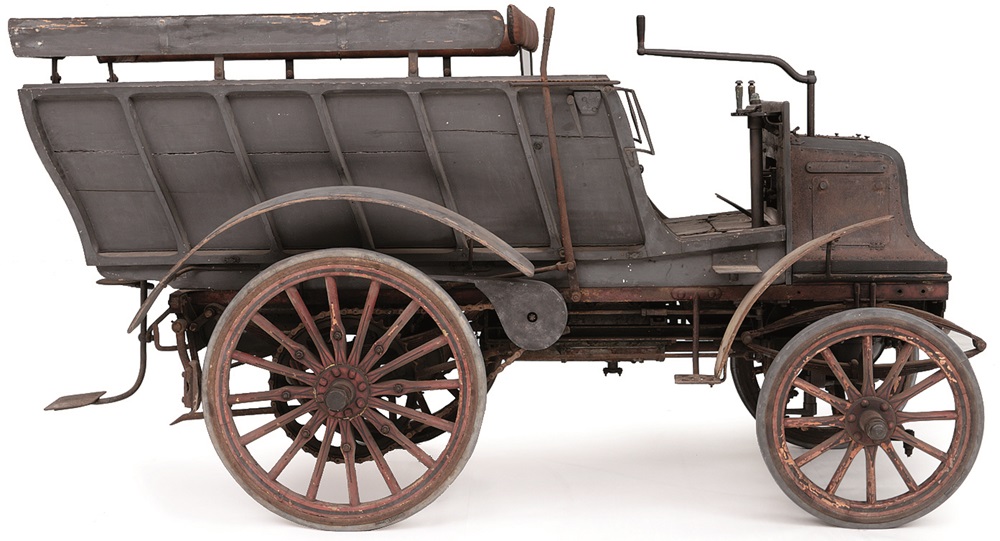1897 Daimler 6-HP Twin-Cylinder Six-Seat Brake

The descriptions of the Classic Cars in the Directory were partly generated or supplemented with the help of artificial intelligence (AI). The content may occasionally not always be entirely accurate or factually correct despite careful checking.
The Daimler 6-HP Twin-Cylinder Six-Seat Brake 1897 is a magnificent creation of automotive engineering. It was designed and manufactured by the Daimler Motoren Gesellschaft in Germany in 1897, and it is undoubtedly one of the finest vehicles of its time.
The vehicle has a power output of 6 horsepower, which is achieved using a twin-cylinder, four-stroke engine that uses a magneto ignition system. The engine has a displacement of 1.3 litres, which is capable of producing a maximum speed of 11 miles per hour. The engine is cooled using a water-cooling system that utilizes a radiator located at the front of the vehicle.
The Daimler 6-HP Twin-Cylinder Six-Seat Brake has a body made of wood, which is supported by a steel frame chassis. The vehicle has a wheelbase of 2650 mm, a front track width of 1194 mm, and a rear track width of 1232 mm. The brakes are only located on the back axle, which is why it is called a 'brake'.
The vehicle has six seats, which are arranged in three rows with two seats in each row. The rear seat can be folded down to create more storage space in the rear of the vehicle. The driver's seat is centrally located at the front of the vehicle, and all the passengers are facing forward.
The Daimler 6-HP Twin-Cylinder Six-Seat Brake has a unique suspension design that utilizes semi-elliptic leaf springs. The front suspension system consists of a single transverse leaf spring, while the rear suspension system has two semi-elliptic leaf springs. The vehicle also has a steering system that employs a worm gear.
The wheels of the vehicle are made of wood and are fitted with solid rubber tires. The rims of the wheels are made of steel, and they are painted red to match the vehicle's bodywork. The vehicle also has a hand-cranked engine starter, which is located at the front of the vehicle.
In conclusion, the Daimler 6-HP Twin-Cylinder Six-Seat Brake 1897 is an excellent example of automotive engineering from the 19th century. It is a vehicle that is built to last, and it has a unique design that sets it apart from other vehicles of its time. This vehicle is an essential part of automotive history and is a must-see for enthusiasts and collectors alike.
Milestones
- The Daimler 6-HP Twin-Cylinder Six-Seat Brake is introduced in 1897. - It is designed by Wilhelm Maybach for Daimler-Motoren-Gesellschaft (DMG). - The vehicle is powered by a twin-cylinder, water-cooled engine with a displacement of 1.5 liters. - It features a four-speed manual transmission and can reach a top speed of 22 mph. - The 6-HP Twin-Cylinder Six-Seat Brake is one of the first automobiles to have a four-wheel brake system, with individual brakes on each wheel. - The car's body is designed for six passengers, with three rows of seats facing each other. - It is marketed as a luxury vehicle for the wealthy class. - The 6-HP Twin-Cylinder Six-Seat Brake becomes a popular model for DMG, with over 200 units produced during its production run from 1897 to 1901. - The success of this model helps to establish DMG as one of the leading automobile manufacturers of its time. - The design of the 6-HP Twin-Cylinder Six-Seat Brake serves as a basis for future Daimler models, including the Mercedes-Benz brand.Technical
- Engine: 6-HP twin-cylinder gasoline engine - Power output: 6 horsepower - Transmission: 2-speed manual transmission - Seating capacity: Six seats - Brakes: Mechanical brakes on all wheels - Suspension: Solid front axle with leaf springs, rear live axle with cantilever springs - Steering: Tiller steering - Top speed: 15 mph - Range: Approximately 50 miles per tank of gas - Weight: 1450 pounds - Dimensions: 136 inches long, 54 inches wide, 68 inches tall